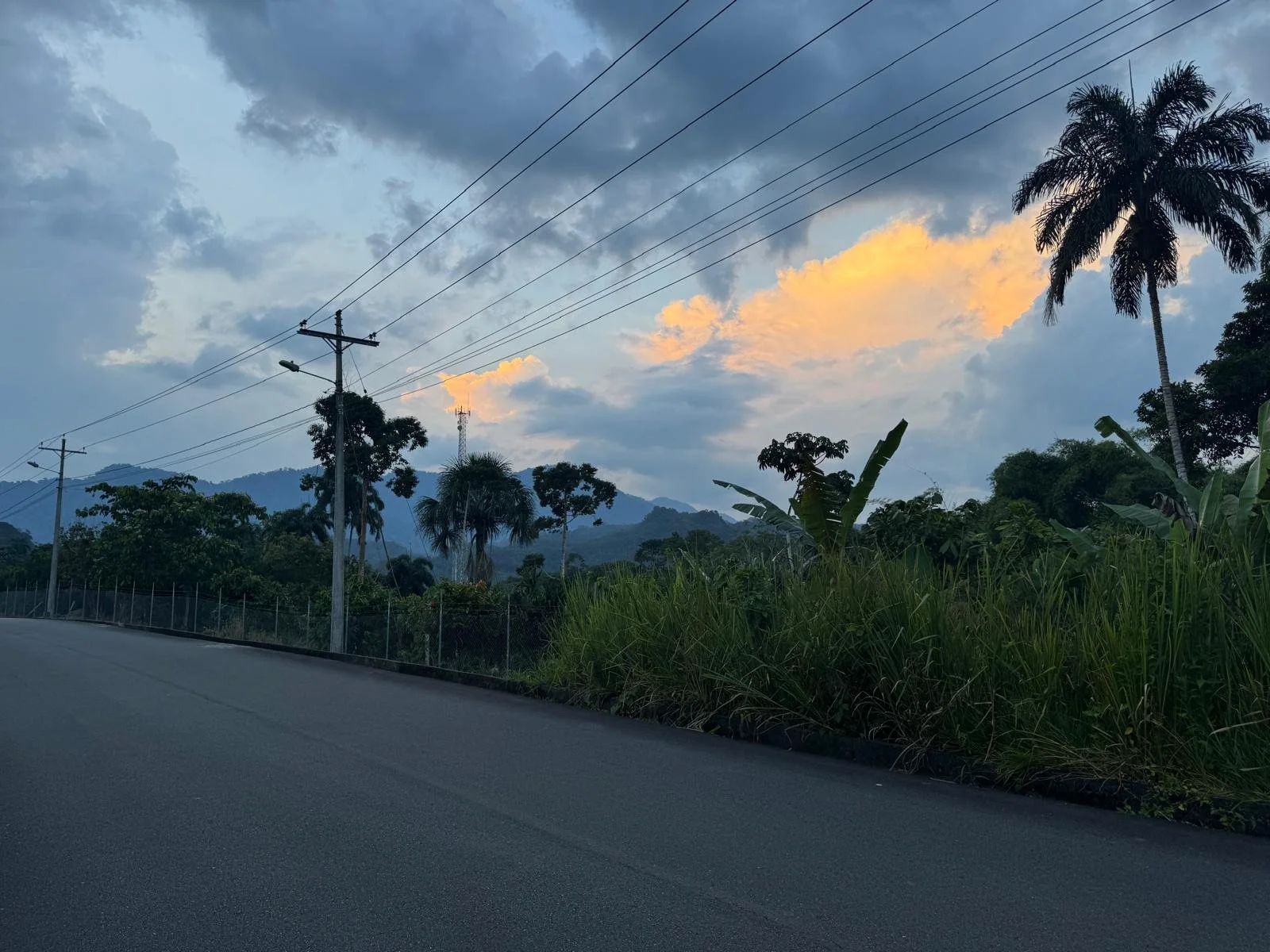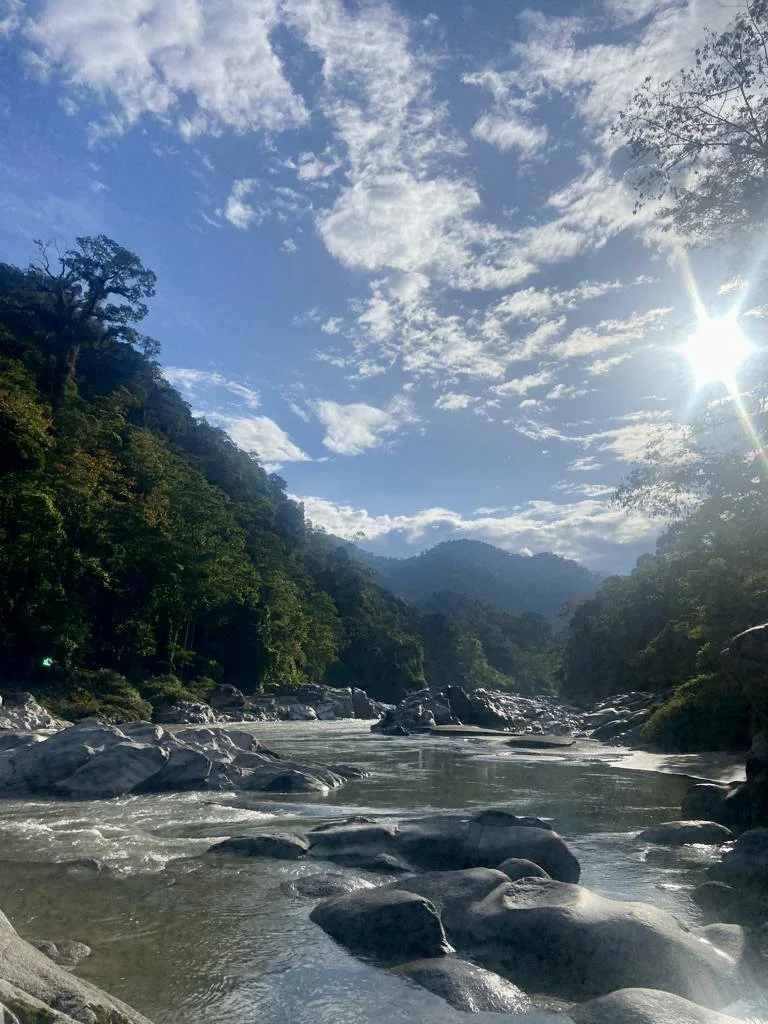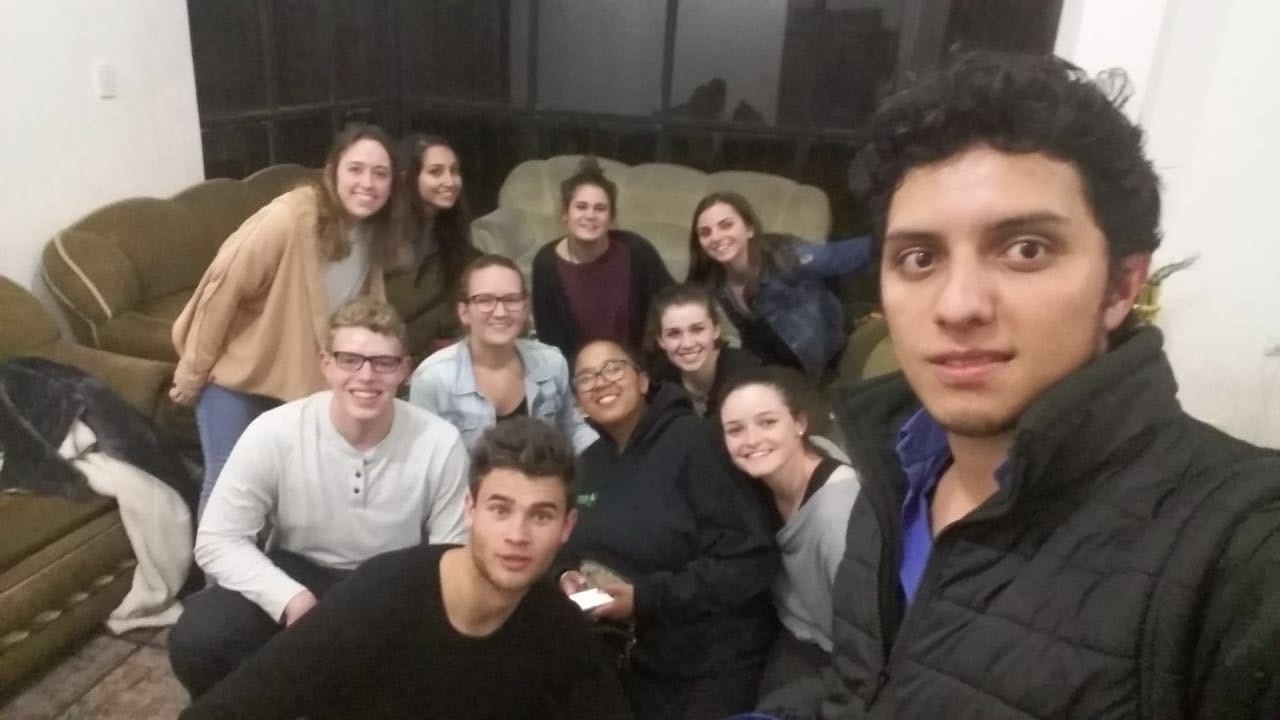There are so many things that you need to consider when you travel abroad or volunteer abroad in 2024 that it’s hard to know where to start! You are probably considering your long term impact on the community and earth, the sustainability of the programs that you’re joining onto, whether or not you’re contributing to a sustainable solution to systemic challenges, the culture that you’re stepping into and how to best respect it, how to make an impact abroad without playing into white saviorism and colonialist tropes, and that’s before you think about your own logistics and challenges.
An Intern Experience in Ecuador
I left Chicago O’Hare to travel to Ecuador feeling extremely excited, but also with the knowledge that I would be taking each and every part of my trip as it came. A month before the trip, I had no inclination that I would be flying down to South America; I was initially accepted into the Manna Project International summer intern program in Nicaragua, but a series of violent protests sparked by pension law changes tossed a wrench into my plans. Manna operates two sites, one in Nicaragua and one in Ecuador; when it was announced that the Nicaragua site would be canceled for the first session, I worked with the Manna staff and my parents to shift my plans for Ecuador.
I wanted to work with Manna in any capacity because it offered several facets that aligned with my academic and personal passions. Most importantly, I am very interested in international community development, having studied it in courses at Vanderbilt such as Latin American Economic Development. Manna operates an effective approach to international community development by partnering with local organizations to provide a holistic development approach to community members. International development can be a difficult task laden with problematic approaches that resemble voluntourism, or the white-savior complex; Manna’s programs start by listening and getting to know the communities they serve, then aligning resources to meet the demonstrated needs. Manna offers the chance to have my feet on the ground, engaging and serving communities in Ecuador, while at the same time learning about a successful international development model.
Since arriving in Ecuador and experiencing the first week of service, I have already had done things very differently than my normal modus operandi back home. One big difference for me: riding the bus. Ecuador has a well-utilized bus system, and I am still nailing down the names of the different buses (Cia Azblan, Libertadores, Los Chillos, Amaguaña, etc.) and the different routes (Conocoto, Rumiloma, La Salle, El Triángulo). I learned that on each bus, rather than having an automated system like buses I am accustomed to in the U.S. there is an “ayudante”, a man or woman who comes up to each passenger and asks for the bus fare. The fare is typically anywhere from 25-35 cents, so I now carry much more change in coins than I ever have. An interesting facet of Ecuadorian bus culture that I have begun to practice myself: although Ecuadorians tend to be very welcoming people, they remove to move from aisle seats to window seats on buses. Any on-boarding bus passenger who spots an open seat is forced to squeeze past the aisle seat passenger, whereas in the U.S. typically the person would just move over. After having squeezed uncomfortably passed a number of people, I myself have started occupying the aisle seat and insisting that people budge past me.
Another hallmark experience from my first week was a community “almuerzo” [lunch] that I was invited to alongside our program directors. One of the women in the level 2 English class beckoned us to come to her family’s house for Ceviche, a traditionally prepared coastal Ecuadorian dish. When we got there, we had a long chat with her husband, who is a serviceman in the Ecuadorian military. Then, we sat down to Ceviche. It was a cold fish soup, prepared with shrimp, tomatoes, lemon juice, cilantro, and a few other ingredients. As is often custom, there were bowls of tostada, popcorn, and chifles [plantain chips], and we were instructed to add some of these other items to the soup. My first bowl was good; I enjoyed pairing the warm tostada with the cold, zesty shrimp soup, and I ate the whole bowl. However, the texture was very different, and honestly I still don’t know how I feel about cold soup. She refilled my bowl and I struggled through the second helping, finishing it not out of a strong taste for the Ceviche, but to satisfy our gracious host.
Looking forward to the rest of the program, I hope to focus on 3 objectives: utilizing my Spanish, making a strong sustainable impact on the community and its programs, and forging strong relationships with the rest of my cohort. I have been listening to Spanish music and starting conversations with anyone who will talk with me, and I plan to prepare extensively for the English classes and other initiatives I am involved in so that I can contribute positively to Manna’s work. Finally, through bus rides and community dinners, I have already had a chance to form bonds with the other interns, and as we serve, learn, and experience Ecuador together, I know those bonds will only deepen and grow.
Celebrating Carnaval in Ecuador
While Ecuadorians celebrate New Years, Easter, Independence Day, and Christmas, no holiday generates quite as much excitement, anticipation, silliness and overall hype as Carnaval. As a foreigner, I had absolutely no idea what to expect, in fact, I did not really even know what Carnaval was – and, boy, did I soon find out!
Historically, Catholics have celebrated Carnaval as a time to indulge in life’s pleasures before a period of solemnity, frugality and fasting in remembrance of Jesus’ suffering on the cross before his death. Therefore, countries around the world celebrate Carnaval with extravagant festivals, elaborate parades, lavish costumes and wild parties in order to “live it up,” so to speak, before the solemn period of Lent. For example, think of Mardi Gras in New Orleans, a masquerade festival in Venice or a flashy parade in Rio de Janeiro. While the Ecuadorian Carnaval l may find some roots in Catholicism, a large part of the festivities stem from ancient, indigenous traditions. To commemorate the end of the solar year, certain indigenous tribes would celebrate by throwing decorative flowers, cooking flour and perfumed water into the air. Over time, these indigenous customs were incorporated into the Ecuadorian Carnaval to create an experience unlike any other.
Nowadays, the indigenous practice of tossing up flowers, flour and water has transformed into an all out water war amongst friends, family and pretty much anyone you see on the street. But the battle doesn’t end with water. In some regions, as in Amaguaña, a farming community just outside of Quito, people douse each other with water, flour, foam, paint and even eggs! For many years, there were no rules about “playing Carnaval.” You could get completely soaked walking down the street, at work, on the bus, anywhere. However, in recent years, new regulations prevent people from playing Carnaval in buildings or on public transportation and from soaking strangers. In fact, to conserve water, local authorities encourage the people to use carioca, essentially shaving cream, instead of water (but, as with most laws, the further away you get from the city, the less the regulations are followed!)
Carnaval in Ecuador varies from city to city. One of the most famous Carnavals is in Guaranda, located in the Bolivar province, which is about four hours from Quito. People travel from all around the country to enjoy the colorful, lively parades of this Andean city. In Guaranda, one can experience the unique combination of indigenous and mestizo folk music, art and dance, drink the traditional “pájaro azul” liquor, and take part in one of the most fun street parties of the entire country. A different style of carnaval celebration takes place in Ambato, a nearby town in la Sierra. Here, the people call the celebration, “La Fiesta de las Flores y de las Frutas.” because the floats of the parade are exclusively decorated with flowers and fruit. On the coast, like in Esmeraldes, Carnaval displays the beauty of the Ecuador’s African American heritage. The parades, food, music, and dancing all reflect the country’s afro-indigenous customs and traditions.
In order to escape the cold of the sierra, we decided to travel to the small beach town of Montañita for our vacation. Little did we know, but what seemed like all of Ecuador was also vacationing in Montañita that weekend as well! Needless to say, the beaches were absolutely packed! For a good chunk of the weekend we squeezed our towels between our fellow beach goers, soaked up the sun and cooled off in the refreshing waves of the Pacific. In town, we found about every type of local and foreign cuisine that you can think of. Street venders sold tons of Ecuadorian food such as tortillas, menestras, pinchos, ceviche, sopas de mariscos, empanadas, juices and smoothies.
During the day, Montañita appeared to be a chill, little surf town on the coast, but, at night, it transformed altogether. The streets were packed with people of all ages buying food from vendors, shopping at the artisanal art stands, and, of course, playing Carnaval. The first night, we were completely unarmed and unprepared. Only one of us had carioca (the foam spray) and, as foreigners, we were even greater targets. So, not surprisingly, we all got completely soaked with water and carioca (luckily flour and paint are not as widely used on the coast). We learned our lesson that night and from then on came armed and ready for battle. Every night, we sprayed each other and random strangers on the beach, in the streets and even in the clubs. All in all it was a great, cultural experience. Plus, as a prankster at heart, I had so much fun sneak attacking people with carioca! All in all, it was a fun, relaxing weekend celebrating Carnaval at the beach in Ecuador!
To experience the fun of traveling in another country and learning about holidays and customs, apply to be a Program Director today!
The Cuenca Chronicles
If you thought that as 5 volunteers living and working together, we’d want to spend our 3-day vacation apart from each other, you thought wrong! A couple weeks ago, this group of friends and coworkers (in that order) decided to venture to the beautiful city of Cuenca for a “family vacation” to celebrate Cuenca’s independence. We packed our bags, boarded a plane (after stuffing 5 people into a cab to the airport like a clown car), and landed in the “Europe of Ecuador” ready for a new adventure. Not only were we in Cuenca to celebrate Cuenca’s Independence, but also Halloween and Ecuador’s Day of the Dead (el Día de los Difuntos). In honor of our Cuenca escapades, I’ve made a list of the Top 10 Things We Learned in Cuenca. Read on, learn something… and laugh a bit, too!
10. Always ask for directions more than once.
We decided as a group to take a day and head to Ingapirca, the Incan ruins. We arrived at the bus stop where, after asking directions for 10 minutes, we finally found a bus headed in some direction. After an hour on the first bus, we were instructed to get off. From there we were told to take another bus, but it was very unclear which one to take. We waited. We asked again. We waited. We bought chips and soda. We then got on a bus we thought might be headed in the right direction and finally, after another hour on the bus, we thankfully began seeing signs for Ingapirca.
9. Donning wigs and dancing like crazy people is fun whether you’re the only ones doing it or not.
For Halloween, we brought our wigs from our Scooby Doo Gang costumes (very red, very blonde, very bright) from Sangolqui to Cuenca. I think we wore the wigs more than we didn’t- and didn’t regret it for a second!
8. McDonald's is wayyyyyyyy better in Ecuador.
No explanation needed.
7. Buying concert tickets at a lentils restaurant is not strange.
In fact, it’s completely normal. After wandering for an hour trying to find the Estadio Doña Menestra (Mrs. Lentils stadium) to buy the tickets for the Chino y Nacho concert we wanted to go to, we stumbled upon the Doña Menestra’s restaurant next to the stadium. Only half joking, we walked into the restaurant to ask about the tickets… and bought them right there at the counter where other people were ordering their lentils. Not weird at all.
6. ATMs are mean.
Plain and simple. After Ayzsa realized her card was not broken, but rather all of the 6 ATMs she had tried were, we all tried the same ones. We were down to our last 5 dollars collectively when we finally saw the golden arches of banks- the Bank of Pichincha. Life improved dramatically afterward.
5. Not all who wander are lost.
We spent one entire day just wandering the streets of Cuenca. Because of the festivals, there were street vendors selling all kinds of foods, drinks and artisanry. There is also a river running through practically the entire city that made for a beautiful walk. While wandering, we saw a sign pointing to Incan ruins in the city. We decided to follow it and ended up at a HUGE and incredible ruin site (which looked nothing like the photo and we later realized was in fact, not the place we were looking for). This was easily one of the coolest things we saw/did while we were there and we actually stumbled upon it. We spent over two hours wandering the ruins and gardens which lay below.
4. It’s okay to eat at the same restaurant more than once.
We found a joint called Chiplote. Yes, you read that right. Not only did Chiplote have the best atmosphere (Reggaeton music from speakers and The Theory of Everything muted playing on the TV screens simultaneously), but the food is to die for. A burrito with French fries inside? Totally worth the second visit.
3. Concerts are fun.
If you don’t know the words, Ecuadorians might yell at you. Fake it ‘til you make it.
2. If you haven’t showered in a shower with lights, a radio, and jets which literally come from every direction, you haven’t lived.
This is not a drill. We are still trying to figure out how to bring this magical showering experience from our Cuenca hotel to the Manna Ecuador House.
1. Traveling is truly a blast.
Traveling with friends makes for some of the best memories of your life. Do it often, and make it count!
See yourself traveling around Ecuador? Apply now!
Seventy-Two Memorable Hours in Colombia
One of the many perks of being a Program Director is being able to travel around and outside of Ecuador on our off days. I fully took advantage of this during the holiday weekend of Guayaquil’s Independence by traveling to Colombia. As both a history and current events buff, I knew Colombia would make an interesting trip because of its recent developments in finalizing a peace deal with its long-time civil war opponent Fuerzas Armadas Revolucionarias de Colombia (FARC).
It would not have been possible to truly see the beauty of Bogotá and the areas surrounding it without the help of hostel owner, Lili. While I was there, she was also hosting study abroad students from Mexico and a backpacker from Finland. Lili showed complete Colombian hospitality with the added bonus of helping me practice my conversational Spanish and pronunciation.
Vincent and Lili
Early on my first morning, I left the city and traveled north to Zipaquirá to visit Catedral de Sal. Yes, you read that right: an underground salt cathedral in a cave. After a tour of the cathedral, I walked around the historic center and enjoyed some true Colombian arepas.
On my second day, I traveled just an hour outside Bogotá to a town called Choachí, which holds the tallest waterfall in Colombia (La Chorrera). It stands at 590 meters (1935 feet) and is such a beautiful sight to behold. Lili brought some of the other hostel guests on a day trip of hiking and swimming. La Chorrera was one of the most incredible landscapes I’ve seen, and I was so surprised that I didn’t see more tourists along the hike coming to visit such a natural wonder.
Of course, a trip to Colombia wouldn’t be complete without a visit to the Historic Center. This was an area I was looking forward to seeing, not only because of its history but also because of the high attention it's been given during Colombia’s recent political developments. We made our way through museums, some of Bogotá’s first restaurants, oldest universities and colonial-era government buildings. Perhaps most interesting was passing the peaceful campers protesting in Bolívar Square.
Despite only spending three days in Colombia, I was quickly able to realize how warm-hearted Colombians are and how deep of a history Colombia has. I will always be grateful to Lili for making my trip unforgettable, and I hope to return as soon as I can.
See yourself spending a weekend in Colombia? Apply now!


















